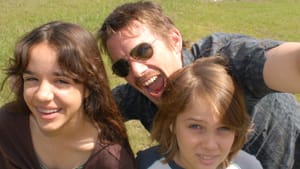Stay in the Loop
BSR publishes on a weekly schedule, with an email newsletter every Wednesday and Thursday morning. There’s no paywall, and subscribing is always free.
What we remember
Richard Linklater’s ‘Boyhood’

Spoiler alert: At the end of Boyhood, Richard Linklater’s epic masterpiece about a boy’s life live tracked over 12 years in real time, 17-year-old Mason (non-actor Ellar Coltrane) delivers a sly, sideways smile.
It’s not a smile full of knowing, or even a smile of pure joy, but a quiet half smile in a particular moment of time. He’s just arrived at college where he’s been swept off by his roommate to sit on a nearby mountain to trip on mushrooms. To his left is a shy, pretty girl he’s only just met. They talk and then comes that smile. A gesture that caps what may be one of the most impressive films that I’ve seen in a long while, but that is, like much of the rest of the film, quiet, understated, and immediately relatable.
Boyhood tells the story of Mason, a five-year-old from Austin, Texas, whom Linklater filmed every year for 12 years, following his actual growth in a fictional story. The movie opens as his mother (a wonderful Patricia Arquette) harangues him about his homework, and his sister Samantha (Lorelei Linklater) taunts him with a Britney Spears song, the two awaiting the arrival of their father (an equally fantastic Ethan Hawke) from Alaska. From the start, there are complicated adult relationships that the two children are helpless to navigate.
Over time, Linklater’s camera follows Mason as his mother leads them through a series of Texas towns, improving her lot through education but making consistently poor choices in men, alternately protecting her children and leaving them to puzzle out their place in dysfunctional family situations.
From the Bible to blue nail polish
Along the way, Mason makes friends, looks at naked pictures with boyish delight, plays video games, and tries to find himself in a dissonant world where his 15th birthday is marked by receiving a shotgun and a Bible, while by 16, he’s wearing blue nail polish and working in a photo lab, developing his skills as a budding artist.
Boyhood develops a language of its own, the rhythms of time pacing the scenes, Mason’s haircuts and growth spurts signaling that another year has come and gone. Music and electronics also mark time, as well as world events – 9/11, the Iraq war, the election battle between Obama and McCain.
The film follows the flow of time and how these moments link to form a life. The artistry of the movie is in how Richard Linklater has curated such moments, has made them so very specific, and out of them has made a picture of change in real time. As you are propelled forward in the movie, tracking the physical changes in all of the actors and their characters, you’re also sent back not only to your own childhood but, if you are a parent, the childhoods of your children. What did they take from their upbringing? What is saved, and what has been lost? What, if anything, is remembered?
As the credits roll, that smile lingers like a Cheshire Cat’s, sending you backward and forward at once: How did the moments we see shape Mason at 18, and where will his life take him now?
For a less enthusiastic review by Paula Berman, click here.
What, When, Where
Boyhood. A film written and directed by Richard Linklater. For Philadelphia area showtimes, click here.
Sign up for our newsletter
All of the week's new articles, all in one place. Sign up for the free weekly BSR newsletters, and don't miss a conversation.

 Ilene Raymond Rush
Ilene Raymond Rush